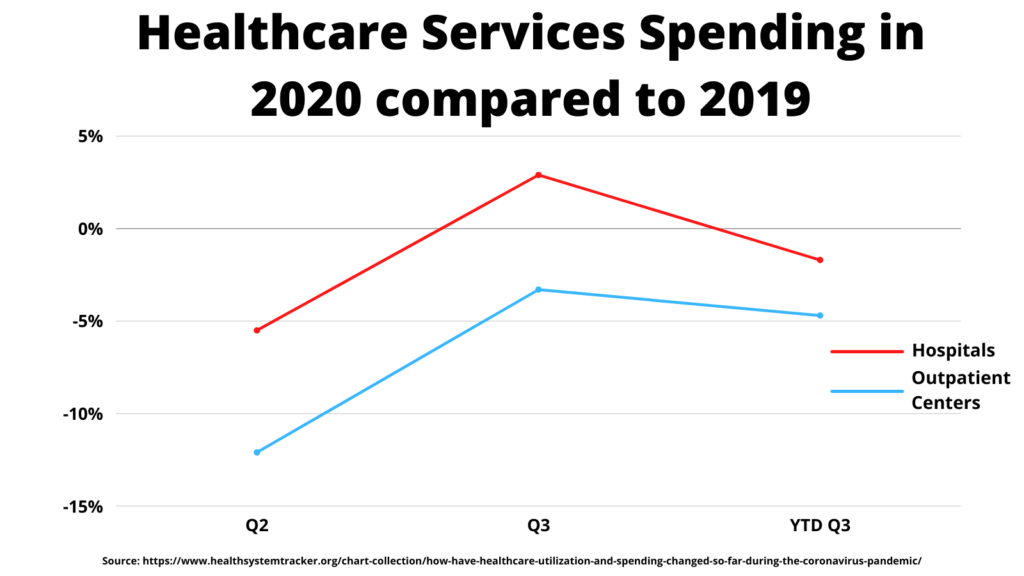The COVID-19 pandemic has been going on for over a year now. As we approach the anniversary of the first wave of shutdowns in the United States, we take a look back at how things have changed in the past year in the world as a whole, and particularly in healthcare. We’ll also look at the road ahead.
COVID-19 & The World
COVID-19 has been devastating worldwide. As of this writing, there have been over 111 million confirmed cases and nearly 2.5 million deaths. The U.S. alone accounts for about a quarter of confirmed cases and nearly a fifth of deaths worldwide. Shutdowns and other lockdown measures across the world have resulted in unemployment rates skyrocketing and most countries experiencing negative GDP growth in 2020. Reduced travel has significantly impacted the airline and hospitality industries. Many jobs have shifted to remote work on at least a part-time basis, with some only recently returning to in-office operations.
Just as the first vaccines began rolling out in December, new variants of the virus emerged around the globe. These variants are:
- B.1.1.7 – The “U.K. Variant”
- B.1.351 – The “South Africa Variant”
- P.1 – The “Brazil Variant”
While these variant strains appear to spread more easily and quickly, leading to an increased infection rate and more strain on healthcare providers, it at least seems current vaccines recognize them. The map below shows confirmed cases of coronavirus variants in the U.S. as of February 23, 2021.

While the pandemic has wreaked havoc around the world, the arrival of vaccines has offered the first ray of hope in the fight against COVID-19.
COVID-19 & Healthcare Providers
If the world has been pushed to the brink because of the pandemic, the healthcare industry itself has been holding on by just a few fingers. Healthcare providers have faced their biggest challenge in over a century. From financials to scheduling to daily operations, COVID-19 has affected providers in numerous ways.
Decreased Volume and Revenue
The start of the pandemic saw a sharp drop in procedures and hospital admissions as lockdown measures were implemented. The uncertainty of the virus led many consumers – 41 percent according to one study released in May 2020 – to delay healthcare services. In the same study, 42 percent of consumers said they felt uncomfortable going to a hospital for treatment. This led to steep decline in non-COVID hospital admissions starting in mid-March. According to an analysis from Kaiser Family Foundation, the week ending April 4 saw the lowest trough with non-COVID hospital admissions reaching only 69.2% of predictions. Admissions slowly returned to normal over the next few months, reaching 95% of predicted admissions in July. While admissions hovered around this mark the rest of 2020, net admissions for the entire year were about 9% less than predicted.
Understandably, this decrease in volume had a financial impact on many hospitals. Hospital revenue in Q2 2020 was down 5.5%. Fortunately, this sharp decline in revenue was somewhat offset by a 2.9% YOY increase in Q3, resulting in a net YOY decrease of 1.7% by the end of Q3. Ambulatory care took the biggest hit among healthcare providers in 2020 with a net decrease of 4.7% by the end of Q3 after an initial dip of 12.1% in Q2. Physician offices were a close second with a net YOY decrease of 4% by the end of Q3.

Changes to Billing and Coding
In an effort to fight COVID-19 and accurately reimburse COVID-related tests and expenses, new CPT codes were established. COVID-related CPT codes cover a wide range of items, including: testing, immunization, additional supply and staff requirements, and more.
For the most up-to-date list of COVID-related CPT codes, refer to this AMA guide.
Effects on Physicians and Staff
The pandemic hasn’t just adversely affected provider revenues. It’s also negatively impacted physicians and staff, making an already major problem like burnout even worse. Notably, 65% of physicians say their family’s well-being has suffered as a result of their work during the pandemic. COVID-19 has also resulted in significant swings in worklife happiness compared to pre-pandemic times.
Healthcare workers have been on the frontlines of the pandemic from the very start. Many have contracted the virus themselves or have seen their patients and even coworkers die from it. Despite it all though, they have been resilient. In a recent Becker’s Healthcare article, healthcare workers credited their colleagues and leaders with helping them through the crisis.
“The teamwork and camaraderie that the staff has felt has made a huge impact. We’re all in this together.”
Jennifer Clutter, RN – Nurse Manager at Mercy Health–St. Elizabeth Youngstown (Ohio) Hospital Emergency Department
For tips on mitigating pandemic-related burnout, check out this Health IT Outcomes article.
Focus on Supply Chain
In the first few months of the pandemic, many providers faced shortages of PPE. This forced staff to reuse PPE such as masks and gloves more than the recommended times. It also forced providers to come up with creative ways of conserving PPE, such as using baby monitors to check on patients remotely. While PPE stockpiles eventually reached adequate levels, many providers have committed to a renewed focus on supply chain management to prevent PPE shortages in the future.
For more ways providers are adapting their supply chains based on lessons learned from the pandemic, read our blog on the topic.
COVID-19 & Health IT
The pandemic has had a profound effect on health IT as well. Unfortunately, cyber criminals have taken advantage of the delicate situation most providers find themselves in and increased their attempts to ransom healthcare data and disrupt operations. One of the few good things to come out of the pandemic though is a healthcare tech revolution. The pandemic has forced the healthcare industry to rapidly adopt innovative solutions and IT vendors to create new ones.
Increase in Cyber Attacks
Cyber attacks against healthcare providers are always terrifying, but perhaps even more so in the midst of a global pandemic. Cyber criminals are well aware of this and have upped the volume of their attacks. In Q3 2020, cyber attacks against healthcare providers were 50% higher than those in the first half of 2020. The pandemic has provided a great opportunity for cyber criminals due to budget restraints. According to a HIMSS healthcare cybersecurity survey released in November 2020, 42% of respondents said their organization allots 6% or less of their IT budget toward cybersecurity. What’s more, 51% of respondents said their cybersecurity budget had either remained the same or decreased compared to 2019. Decreased revenues and devoting resources to fighting COVID-19 likely made healthcare budgets in 2020 even tighter than they already are.
To combat the increase in cyber attacks, read some ways hospitals can remain vigilant even during the pandemic.
Tech Revolution
So far, we’ve mostly discussed COVID-19’s negative outcomes. It hasn’t all been gloom and doom however. The pandemic has led to a tech revolution in healthcare, an industry that has typically lagged behind others in regards to technology. Some of the most important and exciting technologies of this revolution include:
- Artificial Intelligence (AI) – One of the newest innovations is the use of AI in various aspects of healthcare, from predictive analytics to detecting COVID-19 on medical images. While AI can certainly have its advantages, it is still being fine-tuned to ensure accuracy and minimize bias.
- Digital Front Door – “Digital Front Door” is an emerging trend in healthcare that utilizes an array of digital solutions to engage patients at every stage of the care process and provide the best possible patient experience. Components of a digital front door include patient portals, scheduling and billing assistants, navigation resources, and virtual chat/assistance.
- Hospital Command Centers – Many hospitals are establishing command centers to help achieve the goals of improving patient outcomes, flow & efficiency, and inter-facility coordination. Hospital command centers vary in size and responsibilities, but they are essentially a centralized room or virtual platform that allows dedicated staff to monitor various real-time hospital metrics, such as room availability, supplies-on-hand, patient wait times, and even patients’ vital signs.
- Order Management Software – Ambulatory order management software helps streamline workflows, eliminate faxes and back-and-forth phone calls, and improve both patient and physician experience. Our own order management solution, iOrder, also provides patients with preparation instructions, navigation assistance, and procedure specific educational videos. iOrder also has an integrated quality clinical decision support mechanism (qCDSM) that eliminates ICD-10/CPT code mismatches to ensure the right order is placed for the right patient, ensuring patient safety and maximizing reimbursements. These features make iOrder a key part of any digital front door or command center.
- Telehealth – The most significant advancement in health IT to come from the pandemic is the widespread adoption of telehealth. Telehealth has offered a safe alternative to in-person care during the pandemic, allowing providers to consult patients via phone or video and even remotely monitor their health through the use of wearable devices. It’s also provided a new revenue stream for providers in the wake of canceled and delayed in-person care. In fact, from October 2019 to October 2020, telehealth claim lines increased over 3,000%.
Read why industry experts believe healthcare will continue to innovate in 2021.
The Road Ahead
The last year has been one of the most challenging for many, especially those in healthcare. COVID-19 has led to decreased revenues for many providers, exhausted medical supplies, and has exacerbated clinician burnout. It has also led to a spike in cyber attacks against healthcare organizations. A wave of technological innovation in healthcare has been one of the few bright spots in the past year. Fortunately, the future looks brighter. Multiple COVID-19 vaccines are being rolled out, and vaccination rates worldwide are taking off after a slow start. The advancements in health IT should create a better and safer experience for patients. No matter what, we’re all in this together.
To learn how we can partner with you to help achieve your organization’s goals, check out our partnership lifecycle diagram or contact us today.




